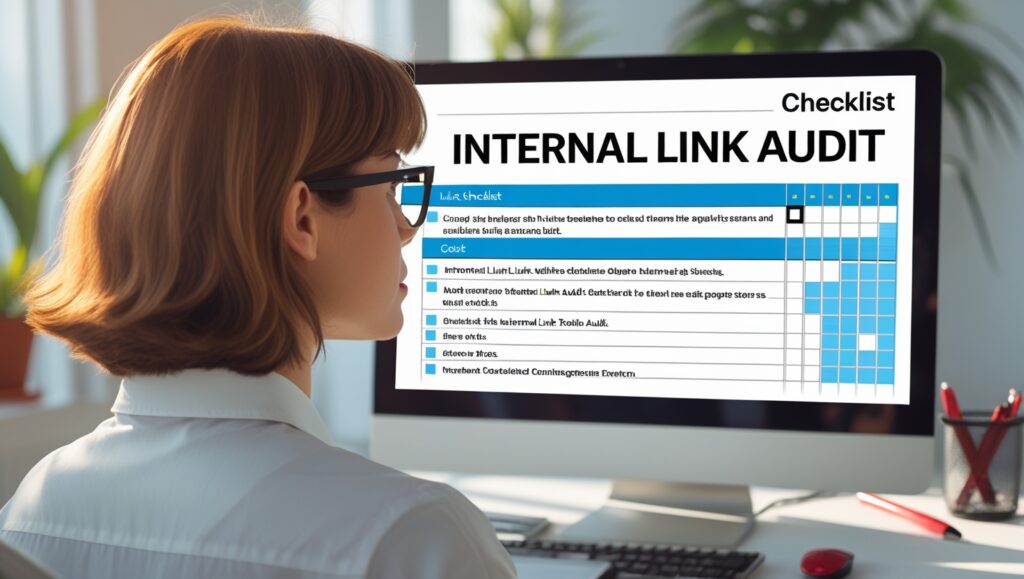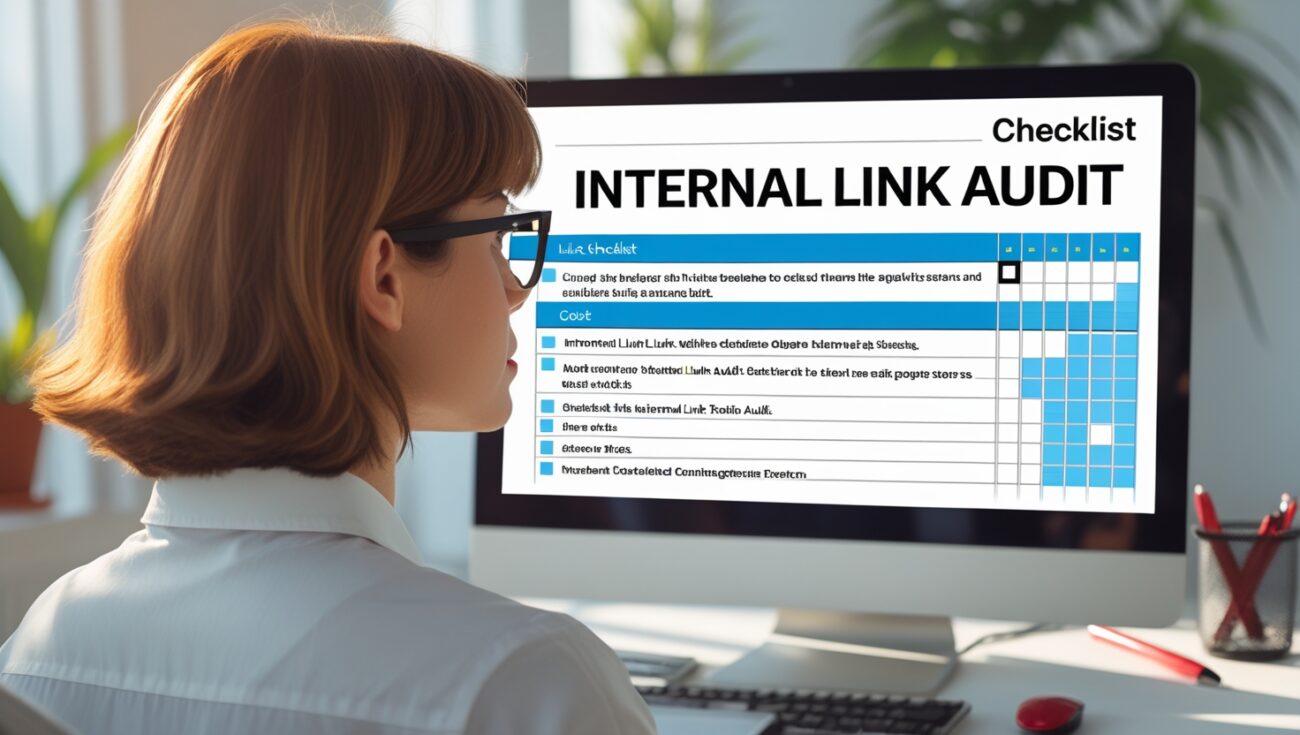The Ultimate Checklist for Your Next Internal Link Audit
As a content creator, I’ve always believed that building a great website is a marathon, not a sprint. You can’t just publish content and walk away. Just like a car needs regular maintenance to perform its best, your website needs a periodic SEO tune-up. One of the most critical, yet often overlooked, parts of this maintenance is an internal link audit.

Table of Contents
An internal link audit is your chance to stop and assess the health of your site’s internal network. It’s the process of finding weaknesses, fixing errors, and optimizing for better performance. I’ve found that a dedicated audit can uncover a surprising amount of lost SEO potential. If you’re ready to make your website more robust and authoritative, here is the ultimate checklist for your next internal link audit.
Internal Link Audit Checklist to Support Google’s Contextual Understanding
If you’ve ever wondered why some pages rank higher even with fewer backlinks, the secret often lies in internal linking. A proper audit checklist for internal links ensures that every connection on your site supports Google’s (or Geo’s, as some SEO pros call it) contextual understanding — meaning search engines actually understand what your site is about, and how each page relates to another.
When I started doing SEO audits, I learned that internal links are more than just navigation tools. They tell Google which topics are connected, which pages are most important, and what your overall website hierarchy looks like. That’s why I created this simple checklist to audit internal links so they support contextual understanding — and I still use it today:
✅ Internal Link Audit Checklist
- Map Your Site Structure
Before you touch any links, visualize your content structure. Create a quick outline of all main topics and subtopics. This gives you clarity on how your internal links should flow contextually. - Use Descriptive Anchor Texts
Replace generic phrases like “click here” or “read more” with context-rich anchor text. Google reads surrounding words to understand meaning — so make it clear what the linked page is about. - Balance Link Depth and Spread
Make sure every key page gets internal links from relevant posts. Avoid having “orphan” pages with no incoming links. Tools like Linkbot can automate this perfectly by detecting which pages need more internal connections. - Check Topical Relevance
Each link should make logical sense to the reader and the algorithm. Internal links that connect unrelated topics can confuse Google’s contextual understanding. - Review Crawl Path Efficiency
Make sure every important page is reachable within 3 clicks from your homepage. The easier it is for Google to crawl, the better its contextual mapping of your site. - Use Hierarchical Linking
Link upward to category pages and downward to detailed articles. This structure helps Google interpret your content relationships more clearly. - Evaluate Outdated Links
Broken or irrelevant links can distort topical relevance. Do a routine audit monthly — or automate the task with Linkbot, which constantly scans and updates your automated internal links. - Analyze with Data Tools
After auditing, review metrics like crawl frequency, impressions, and click depth. Use Google Search Console and internal linking software to measure improvements in topical clarity.
Once I started using this audit framework, I saw an immediate improvement in how Google indexed and ranked my pages. A clear, interconnected site helps search engines form a complete contextual map — and automation through Linkbot makes it even more powerful.
So next time you’re optimizing for SEO, don’t overlook your internal links. They’re not just connections — they’re signals that guide algorithms straight to your most valuable content.
Why an Internal Link Audit is Non-Negotiable
A comprehensive internal link audit is crucial for several reasons:
- Finds Broken Links: Broken links are bad for both user experience and SEO. An audit helps you find and fix these dead ends.
- Uncovers Orphaned Pages: You’ll discover valuable content that is completely cut off from your site’s link network.
- Optimizes Link Equity Flow: It ensures that your most powerful pages are effectively passing authority to the pages you want to rank.
- Improves Site Structure: It gives you a top-down view of your site’s architecture and reveals opportunities for improvement.
The Ultimate Internal Link Audit Checklist
1. Check for Broken Internal Links
This is the most fundamental step. Broken links are a dead end for both users and search engine crawlers, wasting their time and frustrating them. An audit should be the first place you look to find and fix these errors. You can use various tools for this, from simple link checkers to comprehensive SEO platforms.
2. Find All Orphaned Pages
This is a critical, and often surprising, part of the audit. Orphaned pages are articles that have no incoming internal links. They are practically invisible to both users and search engines, and they receive no link equity. Finding these lost pages and linking to them from relevant, authoritative content is one of the quickest ways to boost your SEO. This is a task that automation excels at, and I’ve found it to be a massive time-saver. If you’re ready to uncover these hidden opportunities, start your Linkbot audit today.
3. Evaluate Anchor Text for Relevance and Variety
An effective audit isn’t just about finding links; it’s about evaluating their quality. Do your internal links have descriptive, natural-sounding anchor text? Or are you over-optimizing with the same keyword over and over? Make a point to review your anchor text for both relevance and variety. This ensures your links provide context for both users and search engines. Tools like Linkbot can help you analyze your anchor text to ensure it is natural and effective.
4. Analyze Link Equity Flow
This is where you get strategic. An audit should help you identify which of your pages have the most link equity (from backlinks and other internal links). Then, check to see if those high-authority pages are linking to the pages you want to rank. If they’re not, it’s time to add some strategic links to ensure that valuable authority is being passed where it needs to go.
5. Review Overall Site Structure
Finally, take a step back and look at your entire website’s structure. Are your core topics organized into logical silos? Is it easy for a user to navigate from a broad topic to a more specific one? An audit gives you the data you need to make improvements to your overall site architecture, ensuring it’s easy for search engines to understand.
The Role of Automation in Your Audit
While you can technically do an internal link audit manually, it’s a monumental task for any blog with more than a few dozen articles. This is where automation becomes your best friend. A dedicated internal linking software can perform a comprehensive site crawl in minutes, providing you with a clear report on broken links, orphaned pages, and link equity flow. It takes the pain out of the process, freeing you up to focus on strategy rather than tedious manual work. I highly recommend using Linkbot to perform your next internal link audit.
Conclusion: Make Your Website Work Harder
A regular internal link audit is a non-negotiable part of a successful SEO strategy. By systematically checking for broken links, uncovering orphaned pages, and optimizing your link flow, you can transform your website from a collection of isolated pages into a powerful, interconnected network.
Don’t let your valuable content sit in the shadows. Take control of your site’s SEO and ensure every article you’ve worked so hard on is contributing to your site’s overall authority. Start your ultimate internal link audit with Linkbot and unlock your site’s hidden potential today.
Beyond the direct SEO benefits, a clean internal link profile has a profound impact on user experience. A user who encounters a broken link or a page with no clear next step is more likely to leave your site. An audit ensures that every journey a user takes through your content is smooth and logical, which directly contributes to the “Experience” part of Google’s E-E-A-T framework.
A well-structured and audited site is also a clear signal to search engines that your content is well-maintained and trustworthy. An audit helps you build a logical hierarchy that is easy for bots to crawl. It ensures that every page is getting the attention it deserves, preventing your hard work from being wasted on a page that is practically invisible to search engine crawlers.
It’s important to understand the difference between a simple broken link checker and a full-fledged internal link audit. A checker will only tell you if a link is broken. A comprehensive audit, especially with an automated tool, will tell you why it’s broken, where it’s broken, which pages are orphaned, how your link equity is flowing, and much more. It’s the difference between a simple diagnosis and a full treatment plan.
One of the greatest benefits of using an automated tool for your audit is the “to-do” list it provides. Instead of being overwhelmed by a massive report, a good tool will give you an actionable list of links to fix, orphaned pages to link to, and strategic opportunities to take advantage of. It transforms a monumental task into a series of manageable steps.
I’ve learned that a regular auditing schedule is just as important as the audit itself. I personally aim for a full internal link audit at least once per quarter, or after any major content push. This ensures that any new issues are caught before they can have a negative impact on my SEO and that my site remains a healthy, well-oiled machine.
A well-audited internal link profile also builds your site’s trustworthiness in the eyes of search engines. A website that is meticulously maintained and thoughtfully linked is a clear sign of a professional, authoritative brand. This trust is crucial for ranking, especially in competitive niches.
An audit can also help you uncover content gaps you didn’t even know you had. By analyzing your link structure, you might find a pillar page that has a weak cluster of supporting content, or a topic with no related pages at all. This data can inform your content calendar and help you create articles that will fill a genuine need and strengthen your overall site.
By ensuring every page is part of a healthy link network, you’re also giving it the best chance to rank for a wider variety of long-tail keywords. A page with no incoming link equity is unlikely to rank for anything. A well-linked page, however, can benefit from the authority of its internal links and capture a lot of valuable long-tail search traffic.
I can honestly say that this practice has fundamentally changed my approach to content creation. Instead of just writing and publishing, I now think about every article as a piece of a larger puzzle. I‘m constantly thinking about how a new article can contribute to the health of my older content, and how that older content can give a boost to my new work.
The return on investment of a regular internal link audit is clear. It’s a proactive, foundational SEO task that protects the investment you’ve made in your content. The traffic and rankings you gain from fixing broken links, revitalizing orphaned pages, and optimizing link flow are a continuous return on a small initial effort.
The compounding effect of a consistent auditing process is powerful. Each time you run an audit and fix a handful of issues, you’re making your entire website more authoritative and resilient. The small improvements you make on a regular basis add up to a significant SEO advantage over the long term.
Ultimately, an internal link audit is about ensuring that your website works as hard for you as you’ve worked for it. It’s the difference between having a collection of isolated pages and a powerful, interconnected resource that serves both your users and your SEO goals.

